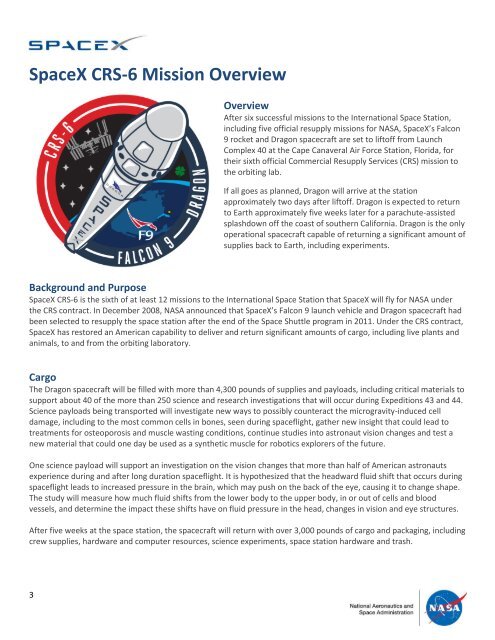spacex_nasa_crs-6_presskit
Create successful ePaper yourself
Turn your PDF publications into a flip-book with our unique Google optimized e-Paper software.
SpaceX CRS-6 Mission Overview<br />
Overview<br />
After six successful missions to the International Space Station,<br />
including five official resupply missions for NASA, SpaceX’s Falcon<br />
9 rocket and Dragon spacecraft are set to liftoff from Launch<br />
Complex 40 at the Cape Canaveral Air Force Station, Florida, for<br />
their sixth official Commercial Resupply Services (CRS) mission to<br />
the orbiting lab.<br />
If all goes as planned, Dragon will arrive at the station<br />
approximately two days after liftoff. Dragon is expected to return<br />
to Earth approximately five weeks later for a parachute-assisted<br />
splashdown off the coast of southern California. Dragon is the only<br />
operational spacecraft capable of returning a significant amount of<br />
supplies back to Earth, including experiments.<br />
Background and Purpose<br />
SpaceX CRS-6 is the sixth of at least 12 missions to the International Space Station that SpaceX will fly for NASA under<br />
the CRS contract. In December 2008, NASA announced that SpaceX’s Falcon 9 launch vehicle and Dragon spacecraft had<br />
been selected to resupply the space station after the end of the Space Shuttle program in 2011. Under the CRS contract,<br />
SpaceX has restored an American capability to deliver and return significant amounts of cargo, including live plants and<br />
animals, to and from the orbiting laboratory.<br />
Cargo<br />
The Dragon spacecraft will be filled with more than 4,300 pounds of supplies and payloads, including critical materials to<br />
support about 40 of the more than 250 science and research investigations that will occur during Expeditions 43 and 44.<br />
Science payloads being transported will investigate new ways to possibly counteract the microgravity-induced cell<br />
damage, including to the most common cells in bones, seen during spaceflight, gather new insight that could lead to<br />
treatments for osteoporosis and muscle wasting conditions, continue studies into astronaut vision changes and test a<br />
new material that could one day be used as a synthetic muscle for robotics explorers of the future.<br />
One science payload will support an investigation on the vision changes that more than half of American astronauts<br />
experience during and after long duration spaceflight. It is hypothesized that the headward fluid shift that occurs during<br />
spaceflight leads to increased pressure in the brain, which may push on the back of the eye, causing it to change shape.<br />
The study will measure how much fluid shifts from the lower body to the upper body, in or out of cells and blood<br />
vessels, and determine the impact these shifts have on fluid pressure in the head, changes in vision and eye structures.<br />
After five weeks at the space station, the spacecraft will return with over 3,000 pounds of cargo and packaging, including<br />
crew supplies, hardware and computer resources, science experiments, space station hardware and trash.<br />
3


